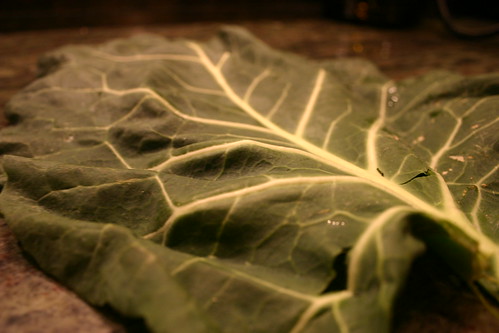
For those of us who try to eat locally year round, greens make up a big part of our Winter diet. Both light greens, like cabbage, and dark greens, kale, spinach and chards, are a savior when tomatoes, eggplants and summer squash are a distant memory. And the great thing about most of these greens is that the cold weather softens and sweetens many greens making them easier to eat and to cook.
The green pictured above is an ancient one, cultivated by the Greeks and Romans. They were brought to America by the British settlers and the name, collard, is derived from the Anglo-Saxon word for cabbage, colewort. Collards were rapidly adopted by the slaves as a substitute for the greens they knew in Africa. As a result, collards remain a staple of the cooking of the American South. They are also popular in Brazil, where according to an old folk tale, a woman isn't ready for marriage until she knows how to shred the green properly.
Like other dark leafy greens, collards are high in fiber and rich in Vitamin C. Collard greens can be long cooked as is common in Southern cooking or flash cooked, especially in the Winter. Here's my favorite recipe for kale, which is somewhere in between. I add a boost of flavor at the end with a bit of glace - highly reduced veal stock, but this isn't necessary especially when the greens are really fresh.

Quick Braised Collards
Serves 4
INGREDIENTS:
1 bunch collard greens
1 tablespoon bacon grease
1 tablespoon veal demi-glace
Kosher salt and freshly ground pepper to taste
METHODS: Remove the hard stems by folding the leaves in half and cutting them away from the stem. Slice about 1/2-inch thick. Heat the bacon grease in a medium-large saucepan. Add the collard greens and cover with water by an inch. Bring to a simmer and cook until tender, approximately 1/2 hour. You may need to add more water. Drop the glace in and simmer for 2 minutes. Season with salt and pepper to taste.





No comments:
Post a Comment